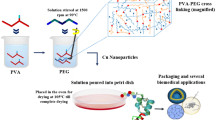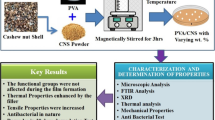Abstract
Renewable multifunctional materials are crucial for advancing industries such as electronics and packaging. This study investigates the potential of graphene nanoplatelet (GNP) and multi-wall carbon nanotube (MWCNT) reinforcement in poly(lactic acid) (PLA)/poly(3-hydroxybutyrate-co-3-hydroxyvalerate) (PHBV) blends for multifunctional packaging. Employing solvent-free techniques, we conducted a comprehensive analysis of morphological, thermal, mechanical, antimicrobial, and biodegradable properties. High-resolution scanning electron microscopy (FEG-SEM) was applied to evaluate the nanofiller morphologies and the immiscibility between PLA and PHBV, while differential scanning calorimetry (DSC) confirmed crystallinity changes induced by carbon nanomaterials. Mechanical tests demonstrated remarkable enhancements, notably a 30% increase in elastic modulus and 195% in ultimate tensile strength. Antimicrobial assays revealed exceptional effectiveness, especially in GNP-containing nanocomposites. Crucially, biodegradation tests highlighted compatibility with the blend. A Life Cycle Assessment (LCA) underscored significant eco-efficiency, minimizing harmful emissions. These findings emphasize the potential of MWCNT, GNP-reinforced PLA/PHBV nanocomposites for diverse applications and as eco-friendly alternatives to conventional plastics.
Graphical Abstract










Similar content being viewed by others
References
Kedzierski M, Frère D, Le Maguer G, Bruzaud S (2020) Why is there plastic packaging in the natural environment? Understanding the roots of our individual plastic waste management behaviours. Sci Total Environ 740:139985. https://doi.org/10.1016/j.scitotenv.2020.139985
Ollinaho OI, Kröger M (2023) Separating the two faces of “bioeconomy”: plantation economy and sociobiodiverse economy in Brazil. For Policy Econ 149:102932. https://doi.org/10.1016/j.forpol.2023.102932
Flury M, Narayan R (2021) Biodegradable plastic as an integral part of the solution to plastic waste pollution of the environment. Curr Opin Green Sustain Chem 30:100490. https://doi.org/10.1016/j.cogsc.2021.100490
Naser AZ, Deiab I, Darras BM (2021) Poly(lactic acid) (PLA) and polyhydroxyalkanoates (PHAs), green alternatives to petroleum-based plastics: a review. RSC Adv 11:17151–17196. https://doi.org/10.1039/D1RA02390J
Ghosh SB, Bandyopadhyay-Ghosh S, Sain M (2010) Composites. Poly(lactic acid). John Wiley & Sons Inc, Hoboken, pp 293–310
Rivera-Briso A, Serrano-Aroca Á (2018) Poly(3-Hydroxybutyrate-co-3-Hydroxyvalerate): enhancement strategies for advanced applications. Polymers (Basel) 10:732. https://doi.org/10.3390/polym10070732
Silva APB, Montagna LS, Passador FR et al (2021) Biodegradable nanocomposites based on PLA/PHBV blend reinforced with carbon nanotubes with potential for electrical and electromagnetic applications. Express Polym Lett 15:987–1003. https://doi.org/10.3144/expresspolymlett.2021.79
Kamarudin SH, Rayung M, Abu F et al (2022) A review on antimicrobial packaging from biodegradable polymer composites. Polymers (Basel) 14:174. https://doi.org/10.3390/polym14010174
Zhong Y, Godwin P, Jin Y, Xiao H (2020) Biodegradable polymers and green-based antimicrobial packaging materials: a mini-review. Adv Ind Eng Polym Res 3:27–35. https://doi.org/10.1016/j.aiepr.2019.11.002
Shankar K, Agarwal S, Mishra S et al (2023) A review on antimicrobial mechanism and applications of graphene-based materials. Biomateri Adv 150:213440. https://doi.org/10.1016/j.bioadv.2023.213440
Scaffaro R, Botta L, Maio A et al (2016) Effect of graphene nanoplatelets on the physical and antimicrobial properties of biopolymer-based nanocomposites. Materials 9:351. https://doi.org/10.3390/ma9050351
Azizi-Lalabadi M, Hashemi H, Feng J, Jafari SM (2020) Carbon nanomaterials against pathogens; the antimicrobial activity of carbon nanotubes, graphene/graphene oxide, fullerenes, and their nanocomposites. Adv Colloid Interface Sci 284:102250. https://doi.org/10.1016/j.cis.2020.102250
de Carvalho APA, Conte Junior CA (2020) Green strategies for active food packagings: a systematic review on active properties of graphene-based nanomaterials and biodegradable polymers. Trends Food Sci Technol 103:130–143. https://doi.org/10.1016/j.tifs.2020.07.012
Iijima S, Ichihashi T (1993) Single-shell carbon nanotubes of 1-nm diameter. Nature 363:603–605. https://doi.org/10.1038/363603a0
Iijima S (1991) Helical microtubules of graphitic carbon. Nature 354:56–58. https://doi.org/10.1038/354056a0
dos Anjos EGR, Brazil TR, de Melo Morgado GF et al (2023) Graphene related materials as effective additives for electrical and electromagnetic performance of epoxy nanocomposites. FlatChem 41:100542. https://doi.org/10.1016/j.flatc.2023.100542
dos Anjos EG, Moura NK, Antonelli E et al (2022) Role of adding carbon nanotubes in the electric and electromagnetic shielding behaviors of three different types of graphene in hybrid nanocomposites. J Thermoplast Compos Mater. https://doi.org/10.1177/08927057221124483
Kim Y, Kim JS, Lee S-Y et al (2020) Exploration of hybrid nanocarbon composite with polylactic acid for packaging applications. Int J Biol Macromol 144:135–142. https://doi.org/10.1016/j.ijbiomac.2019.11.239
dos Anjos EGR, Marini J, Gomes NAS et al (2022) Synergistic effect of adding graphene nanoplates and carbon nanotubes in polycarbonate/acrylonitrile-styrene-butadiene copolymer blend. J Appl Polym Sci. https://doi.org/10.1002/app.52873
dos Anjos EGR, Brazil TR, de Melo Morgado GF et al (2023) Renewable PLA/PHBV blend-based graphene nanoplatelets and carbon nanotube hybrid nanocomposites for electromagnetic and electric-related applications. ACS Appl Electron Mater. https://doi.org/10.1021/acsaelm.3c01099
ASTM (2018) Standard test methods for determining the Izod pendulum impact resistance of plastics 1. ASTM D256. https://doi.org/10.1520/D0256-10R18
ASTM International (2006) Standard test method for tensile properties of plastics. ASTM Int 1:1–15. https://doi.org/10.1520/D0638-14
Ferreira da Silva T, Menezes F, Montagna LS et al (2020) Synergistic effect of adding lignin and carbon black in poly(lactic acid). Polímeros. https://doi.org/10.1590/0104-1428.06819
Vieira L, Montagna LS, Marini J, Passador FR (2021) Influence of particle size and glassy carbon content on the thermal, mechanical, and electrical properties of PHBV/glassy carbon composites. J Appl Polym Sci 138:49740. https://doi.org/10.1002/app.49740
Montanheiro TLA, Campos TMB, Montagna LS et al (2019) Influence of CNT pre-dispersion into PHBV/CNT nanocomposites and evaluation of morphological, mechanical and crystallographic features. Mater Res Express 6:105375. https://doi.org/10.1088/2053-1591/ab42ed
Abushowmi TH, AlZaher ZA, Almaskin DF et al (2020) Comparative effect of glass fiber and nano-filler addition on denture repair strength. J Prosthodont 29:261–268. https://doi.org/10.1111/jopr.13124
ASTM (2022) ASTM D5988–18 Standard test method for determining aerobic biodegradation of plastic materials in soil. In: ASTM Volume 08.03: plastics (III): D5117–latest; reinforced plastic piping systems and chemical equipment; plastic building products.
ASTM (2020) ASTM D2974–20 Standard test methods for determining the water (moisture) content, ash content, and organic material of peat and other organic soils. In: ASTM Volume 04.08: Soil And Rock (I): D420–D5876/D5876m.
ISO (2006) ISO 14044:2006 Environmental management—life cycle assessment—requirements and guidelines.
dos Anjos EGR, Brazil TR, de Melo Morgado GF et al (2023) Influence of MWCNT aspect ratio on the rheological, electrical, electromagnetic shielding, and mechanical properties of polycarbonate melt mixed nanocomposites. J Polym Res 30:89. https://doi.org/10.1007/s10965-023-03453-8
Oyama IMC, dos Anjos EGR, de Morgado GFM et al (2023) Antistatic and antimicrobial packaging of PLA/PHBV blend-based graphene nanoplatelets nanocomposites. J Appl Polym Sci. https://doi.org/10.1002/app.54484
Nagarajan V, Mohanty AK, Misra M (2016) Perspective on polylactic acid (PLA) based sustainable materials for durable applications: focus on toughness and heat resistance. ACS Sustain Chem Eng 4:2899–2916. https://doi.org/10.1021/acssuschemeng.6b00321
Wegrzyn M, Ortega A, Benedito A, Gimenez E (2015) Thermal and electrical conductivity of melt mixed polycarbonate hybrid composites co-filled with multi-walled carbon nanotubes and graphene nanoplatelets. J Appl Polym Sci 132:1–8. https://doi.org/10.1002/app.42536
Pour RH, Hassan A, Soheilmoghaddam M, Bidsorkhi HC (2016) Mechanical, thermal, and morphological properties of graphene reinforced polycarbonate/acrylonitrile butadiene styrene nanocomposites. Polym Compos 37:1633–1640. https://doi.org/10.1002/pc.23335
dos Anjos EGR, Souza Vieira L, Marini J et al (2022) Influence of graphene nanoplates and ABS- g -MAH on the thermal, mechanical, and electromagnetic properties of PC/ABS blend. J Appl Polym Sci 139:51500. https://doi.org/10.1002/app.51500
Bagotia N, Choudhary V, Sharma DK (2019) Synergistic effect of graphene/multiwalled carbon nanotube hybrid fillers on mechanical, electrical and EMI shielding properties of polycarbonate/ethylene methyl acrylate nanocomposites. Compos B Eng 159:378–388. https://doi.org/10.1016/j.compositesb.2018.10.009
Pokharel P, Xiao D, Erogbogbo F et al (2019) A hierarchical approach for creating electrically conductive network structure in polyurethane nanocomposites using a hybrid of graphene nanoplatelets, carbon black and multi-walled carbon nanotubes. Compos B Eng 161:169–182. https://doi.org/10.1016/j.compositesb.2018.10.057
Tokiwa Y, Jarerat A (2004) Biodegradation of poly(l-lactide). Biotechnol Lett 26:771–777. https://doi.org/10.1023/B:BILE.0000025927.31028.e3
Byrom D (1993) The synthesis and biodegradation of polyhydroxyalkanoates from bacteria. Int Biodeterior Biodegradation 31:199–208. https://doi.org/10.1016/0964-8305(93)90005-M
Cai H, Dave V, Gross RA, McCarthy SP (1996) Effects of physical aging, crystallinity, and orientation on the enzymatic degradation of poly(lactic acid). J Polym Sci B Polym Phys 34:2701–2708. https://doi.org/10.1002/(SICI)1099-0488(19961130)34:16%3c2701::AID-POLB2%3e3.0.CO;2-S
de Vieira LS, Montagna LS, da Silva APB et al (2021) Effect of glassy carbon addition and photodegradation on the biodegradation in aqueous medium of poly (3-hydroxybutyrate - co - 3-hydroxyvalerate )/glassy carbon green composites. J Appl Polym Sci. https://doi.org/10.1002/app.50821
Acknowledgements
The authors are grateful to the financial support of CNPq (Conselho Nacional de Desenvolvimento Científico e Tecnológico, processes 407288/2021-0, 307933/2021-0) and FAPESP (Processes 2020/12501-8 and 2021/10136-3).
Author information
Authors and Affiliations
Contributions
EGRA: conceptualization, methodology, formal analysis, investigation, writing—original draft; LSM: validation, writing—review & editing; TRB: formal analysis; GFMM: formal analysis; EFM: formal analysis; LAP: validation; FKVM: formal analysis, validation, writing—review & editing; JM: validation, writing—review & editing; FRP: conceptualization, validation, resources, writing—review & editing, supervision.
Corresponding author
Ethics declarations
Conflict of interest
The authors declare that there is no conflict of interest regarding the publication of this research paper.
Additional information
Publisher's Note
Springer Nature remains neutral with regard to jurisdictional claims in published maps and institutional affiliations.
Supplementary Information
Below is the link to the electronic supplementary material.
Rights and permissions
Springer Nature or its licensor (e.g. a society or other partner) holds exclusive rights to this article under a publishing agreement with the author(s) or other rightsholder(s); author self-archiving of the accepted manuscript version of this article is solely governed by the terms of such publishing agreement and applicable law.
About this article
Cite this article
dos Anjos, E.G.R., Brazil, T.R., Montagna, L.S. et al. Biodegradation Behavior and Life Cycle Assessment of PLA/PHBV/Carbonaceous Materials Hybrid Nanocomposites for Antimicrobial Multifunctional Packaging. J Polym Environ (2024). https://doi.org/10.1007/s10924-024-03286-6
Accepted:
Published:
DOI: https://doi.org/10.1007/s10924-024-03286-6




